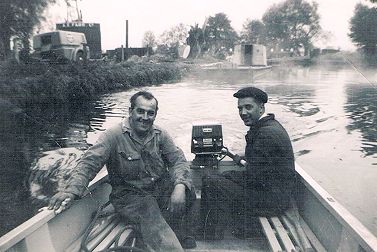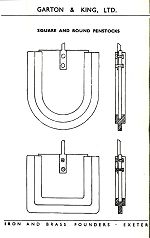

What product could the company possibly produce that would end up with three men in a boat (don’t forget the photographer) swanning around on the Thames near Reading?
Well, the answer is Sluice Gates!
 The three black & white images on this page (right and below) were passed to me by Mike Bendall. He joined the Company in 1959 as an apprentice, overseen by Pat Rodgers, the Machine Shop Foreman at that time. He was the only apprentice amongst 12 fitters, the bottom of the pile as one might say. He recalls a Cyril Randall who looked after the diesel engine that, according to him, powered the large generator that powered most of the lights in the Factory. Amongst those he worked with he recalls were Frank Rice (the wise old man!), John Heard, Pat Smart and Harold Williams – there’s a picture of Harold on the Wheels & Gears page.
The three black & white images on this page (right and below) were passed to me by Mike Bendall. He joined the Company in 1959 as an apprentice, overseen by Pat Rodgers, the Machine Shop Foreman at that time. He was the only apprentice amongst 12 fitters, the bottom of the pile as one might say. He recalls a Cyril Randall who looked after the diesel engine that, according to him, powered the large generator that powered most of the lights in the Factory. Amongst those he worked with he recalls were Frank Rice (the wise old man!), John Heard, Pat Smart and Harold Williams – there’s a picture of Harold on the Wheels & Gears page.
Mike’s father also had a connection with Garton & King, he was the Manager of W.V. Cole & Sons, the Printers in Exeter who printed the original Golden Hammer book that commemorated the Company’s 300th Anniversary in 1961. Mike states that he assisted in the welding and manufacture of these sluice gates which were taken by G & K’s regular driver, Charlie Orchard (seen on the left in the top picture), together with Mike in the Eastmonds lorry to the Reading area where they were unloaded and transferred to a barge
The second and third black & white images appear to be taken in the vicinity of Sulhampstead Weir (?).
A recent post (April 2023) on the Website Guestbook by Tom Weber states:
“I think the sluice gates [on this Website Page] were installed at Sulhampstead Weir on the River Kennet. A set of two identical sluices remain at the weir to this day.
In the background of the photos [the 1st and 3rd Black & White images above] you can see the tree lined derelict cut to Sulhampstead Lock. You can also see what looks like a line of sluices to be replaced - the white covers are the winding gear for each gate. I imagine a number of these sluice gates were commissioned as there is another identical pair above Sheffield Lock near Theale.”.
The first colour image (below left) is of Sulhampstead Sluice. This sluice is roughly 7 miles south west of Reading on the Kennett & Avon Canal. Those located at Sheffield Lock (below right) are of an almost identical design, know possibly as Black Hatches. Compare the design to that in the second of the three black & white images (above left).
Tom Weber also comments:
“There is also a set of 3 sluices at Colthrop Lock [two photos below]. These have had actuators fitted but I remember them before this and the central gate had a large handwheel like those at Sulhampstead and the Black Hatches at Sheffield Lock.. There are braces in the corners of the frame just like the other sluices. The second photo of Colthrop shows the upstream side where the stem meets the gates. This too looks like the same setup as the other sluices.”
It is presumed that the materials needed to construct the sluices were unloaded from Eastmond’s lorry and assembled near to their place of installation. A crane belonging to A E Farr & Sons, of Westbury, Wiltshire which can be seen in the first and second black and white images possibly then lifted the assembled sluices into position. A E Farr & Sons had at one time a Head Office at Station Road in Westbury and were a firm of Civil Engineering Contractors which had been in existence since the 1920s. It became A E Farr Ltd in August 1924.
 These Sluice Gates (also ‘Penstocks’ - a sluice or gate or intake structure that controls water flow) were a product the Company made to order. As I am uncertain as to the date of the Black & White images, I can only guess as to the approximate year when this work was carried out - I would suggest probably in the late 1960s. The foundry produced some smaller single penstocks in cast iron - this drawing is from a catalogue dated sometime after 1952.
These Sluice Gates (also ‘Penstocks’ - a sluice or gate or intake structure that controls water flow) were a product the Company made to order. As I am uncertain as to the date of the Black & White images, I can only guess as to the approximate year when this work was carried out - I would suggest probably in the late 1960s. The foundry produced some smaller single penstocks in cast iron - this drawing is from a catalogue dated sometime after 1952.
Updated May 2023
Top of Page
See also:
Transport — Products
A Little Bit Unusual — Mixed Bag
Sitemap / Contents